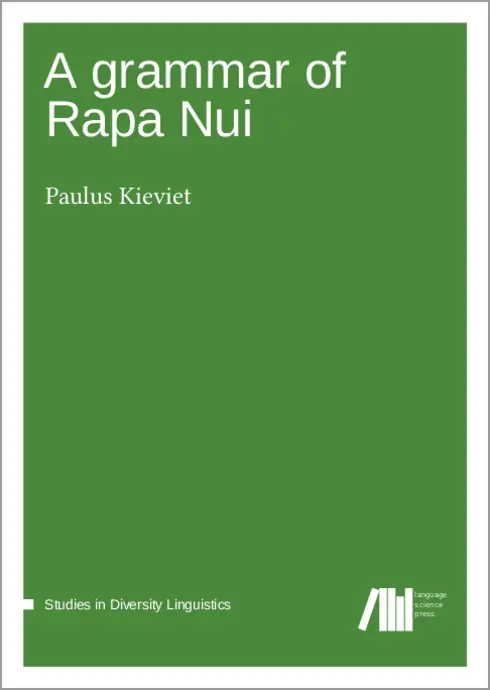
A grammar of Rapa Nui
No ratings
Paulus Kieviet
Copyright Year:
Publisher: Language Science Press
Language: English
Formats Available
Conditions of Use
![]() Attribution
Attribution
CC BY
Table of Contents
- Chapter 1: Introduction
- Chapter 2: Phonology
- Chapter 3: Nouns and verbs
- Chapter 4: Closed word classes
- Chapter 5: The noun phrase
- Chapter 6: Possession
- Chapter 7: The verb phrase
- Chapter 8: The verbal clause
- Chapter 9: Nonverbal and copular clauses
- Chapter 10: Mood and negation
- Chapter 11: Combining clauses
About the Book
This book is a comprehensive description of the grammar of Rapa Nui, the Polynesian language spoken on Easter Island. After an introductory chapter, the grammar deals with phonology, word classes, the noun phrase, possession, the verb phrase, verbal and nonverbal clauses, mood and negation, and clause combinations. The phonology of Rapa Nui reveals certain issues of typological interest, such as the existence of strict conditions on the phonological shape of words, word-final devoicing, and reduplication patterns motivated by metrical constraints. For Polynesian languages, the distinction between nouns and verbs in the lexicon has often been denied; in this grammar it is argued that this distinction is needed for Rapa Nui. Rapa Nui has sometimes been characterised as an ergative language; this grammar shows that it is unambiguously accusative. Subject and object marking depend on an interplay of syntactic, semantic and pragmatic factors. Other distinctive features of the language include the existence of a ‘neutral’ aspect marker, a serial verb construction, the emergence of copula verbs, a possessive-relative construction, and a tendency to maximise the use of the nominal domain. Rapa Nui’s relationship to the other Polynesian languages is a recurring theme in this grammar; the relationship to Tahitian (which has profoundly influenced Rapa Nui) especially deserves attention. The grammar is supplemented with a number of interlinear texts, two maps and a subject index.
About the Contributors
Author
Paulus Kieviet obtained MAs in Semitic Languages (1997) and General Linguistics (1998) from Leiden University, both cum laude. In 2016, he obtained a PhD from VU University, Amsterdam. Since 2002, he has been a member of SIL International. He has worked as a Bible translation consultant in several Polynesian languages, such as Rapa Nui, Pa’umotu (French Polynesia) and Nukuoro (Federated States of Micronesia). With his family, he lived in Papua New Guinea (2002-2003), French Polynesia (2004-2007) and on Easter Island (2007-2010).
